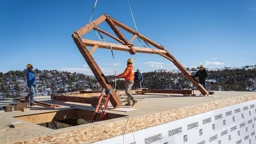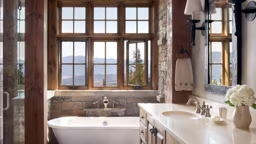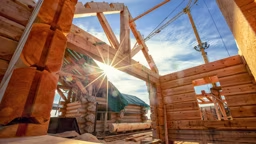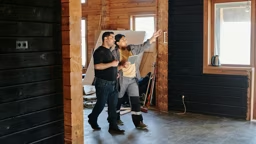
You love the classiness of timber structures. You’re attracted to the traditional look of logs. There’s some cool textured stone on your land that would be perfect as a fireplace or pillar footing. Barn wood siding would be nice for the mudroom. And you have your eye on some exotic hardwood for your flooring.
How can you possibly combine all these materials?
Your dream home might be a hybrid home — a custom wood home that combines a number of building materials and construction elements in the same structure, creating a home that’s far more than the sum of its many parts.
There are several names to this type of home, including mountain architecture, natural element, natural material and log-and-timber combo. Many companies offer this type of house as part of their repertoire and may call it something like a signature series.
A Flexible Style
Generally speaking, hybrid homes are those that incorporate a substantial amount of conventional stick-frame construction juxtaposed against more natural-looking materials, such as full-log walls or log veneer, timber frame or stonework. The fact that hybrid homes do such a great job of combining different elements creates a wealth of wow factor — and raises the bar on your ability to customize and personalize your dream home. The possibilities offered by hybrid home construction mean that people who might not have felt comfortable with any one single flavor of home design can venture into new architectural territory. Instead of a home that’s completely log or completely timber, you can create a structure that blends different looks and reflects its natural surroundings.
Aesthetically, a hybrid home with timber frame or log in only part of the house (perhaps on the exterior or in certain interior spaces) can give a lighter, more transitional feel. Plus, conventional construction in a hybrid home frees your design from some of the constraints of log or timber frame architecture. “You might love the look of a log home, but there are certain issues with a full-log home that you don’t have to have with a hybrid home,” says Erwin Loveland of Tennessee-based MossCreek Designs. “For instance, with a hybrid you can put very large windows into the home without worrying so much about whether the window is compromising the wall’s strength or how the logs will settle.”
Hybrid Homes: Room By Room
Accent Materials
The key to doing justice to all the elements in a hybrid home is using accent materials in all the right places — and knowing when to stop. The more public a space is, the more you’ll want to show it off. So, for example, in the great room, you might want to opt for timber frame construction exposed to the interior or elaborate ceiling truss work that creates a lot of visual attention. And, to some extent, master suites are getting more attention. Their ceilings are the first thing you see in the morning and the last thing you see at night.
Kitchens
Kitchens are prime spots for traditional construction, giving you flat walls that can easily support cabinets and appliances. But by beefing up your conventional construction to support a little extra weight, you can add decorative woodwork on the ceiling, or graft on reclaimed wood beams or trim, giving the kitchen more architectural interest and warmth, and a sense of history, too.
Upper Floors
Designers recommend that you keep construction conventional in kids’ rooms or other areas that might see rough treatment, though. “Rooms that are located on an upper floor are more likely to have a flat ceiling, which doesn’t leave a lot of room for timber frame elements,” notes Loveland. “Kids may do things like draw on walls and add a few dings here and there. It’s probably better to just use drywall for your children’s bedroom walls, because it’s easier to repair than, for instance, wainscoting made from an exotic or hard-to-harvest wood.”
Outdoor Rooms
Outdoor rooms, however, are a good place to put aside conventional construction and let the natural elements of your hybrid take over. Log trellis add-ons are popular options for outdoor rooms, or using decorative veneers like barn board on the walls inside and out to help transition between indoor and outdoor spaces.
As insurance, make sure you find a design professional who really understands the products with which the house is going to be built, and who can act as a good resource for finding particularly interesting materials. “You can build a new dream home with all the amenities, and have it look like it’s been there forever. The trick is making all the components work to give you that look,” Loveland explains. “What a quality hybrid home does well is give you the conveniences of conventional construction, but with natural elements that make your dream home look like it really belongs.”
Read More About Hybrids from Timber Home Living:











